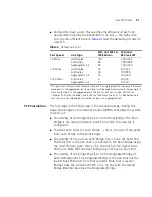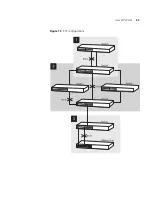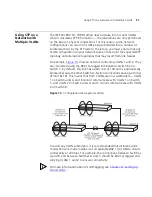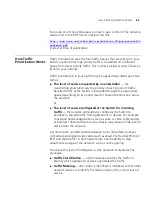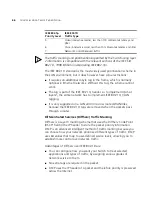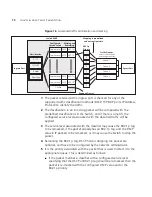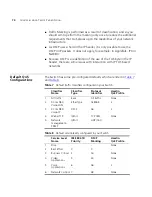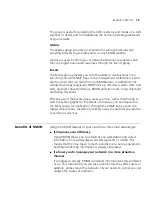
64
C
HAPTER
6: U
SING
T
RAFFIC
P
RIORITIZATION
■
Traffic Remarking
— if a traffic packet enters the Switch with a
priority marking requesting an unacceptable level of service, the
Switch can Re-mark it with a different priority value to downgrade its
level of service.
■
Traffic Prioritization
— once the network can differentiate types of
traffic, for example, a telephone conversation from Web surfing,
prioritization can ensure that a large download from the Internet does
not disrupt the telephone conversation.
■
Dropped Traffic
— traffic can be discarded either because it has an
unacceptable marking or if it is of a type that is prohibited on the
network, for example, an unwanted application or to/from a
prohibited device.
Traffic Classification
To determine the service level to be applied to each incoming traffic type,
each packet or frame must first be classified. Traffic classification is the
means of identifying which application, device or user generated the
traffic.
The Switch employs several methods of classifying (identifying) traffic.
These can be based on any combination of fields in the first 64 bytes of
the packet, and at different levels of the OSI 7 layer model as shown in
Table 5
.
Table 5
Attributes on which incoming traffic can be classified (identified)
OSI Layer and Protocols
Summary of Protocols
Layer 2
■
IEEE 802.1D priority
■
EtherType
Chatty protocols such as AppleTalk and IPX, used
by a small number of older devices, can cause
traffic delays. Identifying and prioritizing data
based on these protocols can reduce delays.
AppleTalk can be identified by its EtherType of
0x809B, and IPX can be identified by EtherType
0x8137.
Layer 3
■
Destination IP address
■
Source IP address
■
IP protocols: (ICMP, IGMP,
RSVP, UDP, TCP, etc)
■
DiffServ code point (DSCP)
Many applications are identified by their Source
IP address, or IP protocol. Because servers are
sometimes dedicated to single applications, such
as email, the Source IP address or protocol in a
packet can identify which application generated
the packet.
As well as being a traffic marking mechanism,
the DSCP field in the IP header can also be used
to classify traffic.
Содержание 3C17205-US - Corp SUPERSTACK 3 SWITCH 4400...
Страница 8: ...GLOSSARY INDEX...
Страница 14: ...14...
Страница 26: ...26 CHAPTER 1 SWITCH FEATURES OVERVIEW...
Страница 44: ...44 CHAPTER 3 USING MULTICAST FILTERING...
Страница 55: ...How STP Works 55 Figure 13 STP configurations...
Страница 58: ...58 CHAPTER 4 USING RESILIENCE FEATURES...
Страница 84: ...84 CHAPTER 7 STATUS MONITORING AND STATISTICS...
Страница 92: ...92 CHAPTER 8 SETTING UP VIRTUAL LANS...
Страница 98: ...98 CHAPTER 9 USING WEBCACHE SUPPORT...
Страница 120: ...120 CHAPTER 12 POWER MANAGEMENT AND CONTROL...
Страница 122: ...122...
Страница 126: ...126 APPENDIX A CONFIGURATION RULES...
Страница 134: ...134 APPENDIX B NETWORK CONFIGURATION EXAMPLES...
Страница 150: ...150 GLOSSARY...


